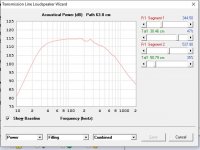Hi there, I am attempting to design a subwoofer enclosure that will be part of an active crossover 3 way project. This will be my first transmission line project, so I'd like to check with someone with experience.
I'm using A single Dayton DCS205-4 8" driver. I'm aiming for f3 between 25Hz and 28 Hz. The spl graph looks too good to be true, espessially when filling is applied. As this is for a 3 way I would like to get enough bandwidth to be able to X-over above 200Hz.
I don't have the driver yet, so the t/s parameters are from datasheet.
The distance between port and driver is 63cm which takes out the drop from 198 to 280Hz. Will I be able to dampen the peaks with wadding material? Im hoping if i can smooth them enough, then FIR filtering or a few biquads can do the rest with DSP.
I'm fairly new to Hornresp, does it simulate the driver as a point source? If so, given that the cone physically extends over a portion of the pipe, will the real enclosure correct the harmonics in the same way?
Speaker displacement could be an issue, so I will have to be careful with the lowpass design. I have attached images with and without the filter.
I'll post sketchup models when i get work out something that fits.
I'm using A single Dayton DCS205-4 8" driver. I'm aiming for f3 between 25Hz and 28 Hz. The spl graph looks too good to be true, espessially when filling is applied. As this is for a 3 way I would like to get enough bandwidth to be able to X-over above 200Hz.
I don't have the driver yet, so the t/s parameters are from datasheet.
The distance between port and driver is 63cm which takes out the drop from 198 to 280Hz. Will I be able to dampen the peaks with wadding material? Im hoping if i can smooth them enough, then FIR filtering or a few biquads can do the rest with DSP.
I'm fairly new to Hornresp, does it simulate the driver as a point source? If so, given that the cone physically extends over a portion of the pipe, will the real enclosure correct the harmonics in the same way?
Speaker displacement could be an issue, so I will have to be careful with the lowpass design. I have attached images with and without the filter.
I'll post sketchup models when i get work out something that fits.
Attachments
-
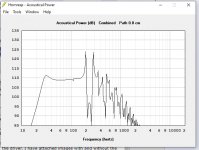 DCS205-4 hornresp 1 - no port offset.jpg73.2 KB · Views: 232
DCS205-4 hornresp 1 - no port offset.jpg73.2 KB · Views: 232 -
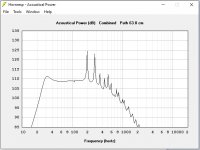 DCS205-4 hornresp 2 - 630mm port offset.jpg65.7 KB · Views: 230
DCS205-4 hornresp 2 - 630mm port offset.jpg65.7 KB · Views: 230 -
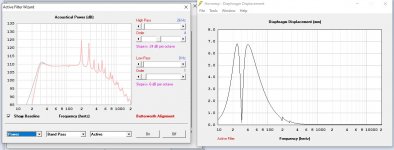 DCS205-4 hornresp 3- lowpass filter.jpg132.6 KB · Views: 214
DCS205-4 hornresp 3- lowpass filter.jpg132.6 KB · Views: 214 -
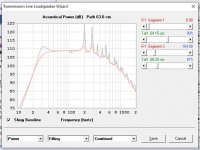 DCS205-4 hornresp 4- filling.jpg75.3 KB · Views: 221
DCS205-4 hornresp 4- filling.jpg75.3 KB · Views: 221 -
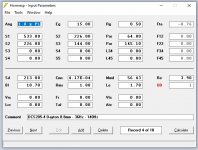 DCS205-4 hornresp 5- settings.jpg83.7 KB · Views: 216
DCS205-4 hornresp 5- settings.jpg83.7 KB · Views: 216 -
DCS205 OTL.txt1 KB · Views: 48
HornResp cuves hard to read if you don’t damp it.
F3 is a meaningless number to humans (ref Toole). pkay F6 and F10
pkay F6 and F10
The simulated response looks to be underdamped, do not forget about room gain.
As well, 2 (or more) subs are much better than 1. With 1 you will have maximum room modes, which will significantly affect the response you get thruout the room.
dave
F3 is a meaningless number to humans (ref Toole).
The simulated response looks to be underdamped, do not forget about room gain.
As well, 2 (or more) subs are much better than 1. With 1 you will have maximum room modes, which will significantly affect the response you get thruout the room.
dave
Thanks Dave!
I've added some more filling and attached an image. The room is 7m at its longest so the fundamental frequency should be roughly 24Hz ?? What sort of fall off should I be designing for?
This will be a pair of subs, each as a bass cab underneath a 2 way.
I've added some more filling and attached an image. The room is 7m at its longest so the fundamental frequency should be roughly 24Hz ?? What sort of fall off should I be designing for?
This will be a pair of subs, each as a bass cab underneath a 2 way.
Attachments
Last edited:
Good to know, shortest dimension is 3.7m, so more like 50Hz.
Fixed the upload, sorry about that.
Would you recommend re tuning the box higher, or would I be able to get the desired slope more easily with the DSP (this is part of a larger project including a ADAU1467 and class d amps)
Fixed the upload, sorry about that.
Would you recommend re tuning the box higher, or would I be able to get the desired slope more easily with the DSP (this is part of a larger project including a ADAU1467 and class d amps)
you have modelled your speaker with only Pi*1 (90°) radiation, that would be in a room corner and has +12dB more bass output.
Usually free standing speakers are measured 4*pi.
Another thing is the damping of a TL. Very complex with different materials and densities. Difficult to model with Hornresp
Any folds are not possible to model either. The App is just one dimensional, very good for short straight horns only
Usually free standing speakers are measured 4*pi.
Another thing is the damping of a TL. Very complex with different materials and densities. Difficult to model with Hornresp
Any folds are not possible to model either. The App is just one dimensional, very good for short straight horns only
Last edited:
Subwoofer boxes are usually located on the floor, not mounted up on a pedestal, hence 2xPi space is the best way to model them.
Baffle-step is something entirely different - and usually not really applicable to subwoofers, unless it's a really BIG subwoofer, such that the "step" occurs within their passband.
Baffle-step is something entirely different - and usually not really applicable to subwoofers, unless it's a really BIG subwoofer, such that the "step" occurs within their passband.
2Pi implies no baffle step, only when you have the speaker inside the wall, flat surface.
Well sort of. If the step of a woofer placed against a wall is less than a quarter wavelength there is essentially no transition, no baffle step, and one needs a speaker that is well damped.
dave
Maybe something in these I saved, but yet to use:
Akabak for beginers - Free Speaker Plans
AkAbak for Dummies | AVS Forum
| AVS Forum
Akabak for beginers - Free Speaker Plans
AkAbak for Dummies
Campio, Ill give you some gold if you run it through the sluice? You can make fun of me if its fools gold !!??
Im quite sure i tossed all my marbles at horn response and theres nothing or the popukar use of that wiuld allow me to actively learn the ahkabak 3.O tsking up soace on my laptop. Ive realky enjoyed it in the oadt when i dabbled in it. But im all in on HR... and i think thats a genuine srarement from the right side occypitol lobe, haaa!
Im quite sure i tossed all my marbles at horn response and theres nothing or the popukar use of that wiuld allow me to actively learn the ahkabak 3.O tsking up soace on my laptop. Ive realky enjoyed it in the oadt when i dabbled in it. But im all in on HR... and i think thats a genuine srarement from the right side occypitol lobe, haaa!
Last edited:
Hmm looks like these tutorials are for the old version, new version uses boundary element modeling. I'm going to learn how to use it. If I were to make some tutorial videos myself, do you think they would be useful to the community?
Yes. But only to things outside if the ‘almost’ covered by hornreponse areas that exist, but dont have much more left to explore without going into details that require more than arent already more than adequate and easier to copy. Its only the pioneeri g and motivated to fail and recover whos gonna fall ibto that rabbit hole. And quickly dven tjose get trapped and cant find ‘the next idea’ to satisfy the actual sawdust vs simulation constipation. Its a curse!
If I were to make some tutorial videos myself, do you think they would be useful to the community?
Me personally, no because I was able to follow the original's manual before there were tutorials and even now only use videos for stuff I can't find any useful info/drawings without owning an expensive service manual.
Folks 'hooked' on videos to get through life though will no doubt prefer them, but like the original I doubt few DIYers will opt to use V3 either.
I have been using the old version for 30+ years.
Akabak is a professional program for a very complex task, so do not expect the sliders of Hornresp. that is toy-stuff.
I liked the script input. It was already difficult to learn, because only the paid version had useful help, but a cheap book was published by the author (Panzer) which helped a lot.
Already active and passive filters for xover could be combined, measurement curves read-in...
Unfortunately last OS functioning was XP.
I am also struggling to learn vers.3 which is completely different. Still modelling a TL enclosure. The calculations take forever and cannot be stored with the free version, but you can simplify the nets and use more detailed for the final calc.
In the moment I am fiddling with damping material simu
Akabak is a professional program for a very complex task, so do not expect the sliders of Hornresp. that is toy-stuff.
I liked the script input. It was already difficult to learn, because only the paid version had useful help, but a cheap book was published by the author (Panzer) which helped a lot.
Already active and passive filters for xover could be combined, measurement curves read-in...
Unfortunately last OS functioning was XP.
I am also struggling to learn vers.3 which is completely different. Still modelling a TL enclosure. The calculations take forever and cannot be stored with the free version, but you can simplify the nets and use more detailed for the final calc.
In the moment I am fiddling with damping material simu
Last edited:
- Status
- This old topic is closed. If you want to reopen this topic, contact a moderator using the "Report Post" button.
- Home
- Loudspeakers
- Subwoofers
- Please critique my hornresp sub design (offset tapered TL sub design)
